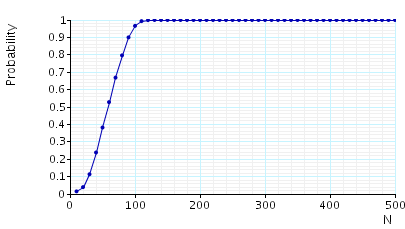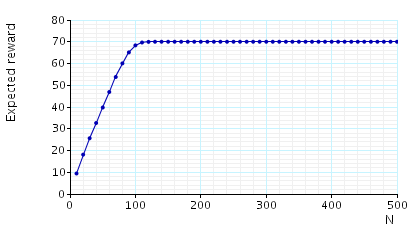(Haring, Marie, Puigjaner and Trivedi)
This case study is based on a single cell in a wireless communication network. It is taken from [HMPT00]. The model includes the phenomenon of hand off which we now explain.
When a mobile station moves across a cell boundary the channel in the earlier cell is released and an idle channel is required in the target cell. If an idle channel is available in the target cell the hand off is resumed and otherwise the hand off is dropped.
Since dropping of a hand off is generally considered more serious than blocking, to reduce the probability of a hand off being dropped, a guarded channel scheme (GCS) is used: a fixed number of channels (called guarded channels) are reserved exclusively for the hand off calls.
The model is represented as a CTMC. We use N to denote the number of channels in the cell and suppose that the number of guarded channel is 20% of the total number of channels. The PRISM source code for this case study is given below.
// single cell in wireless communication network [HMPT01] // gxn/dxp 5/3/01 ctmc const int N; // N - number of channels const double lambda1=49; // arrival rate of new calls const double lambda2=21; // arrival rate of hand-off calls const double mu=1; // departure rate of calls module cell n : [0..N]; // number of calls in the cell // arrival of new call [] (n<N*0.8) -> lambda1 : (n'=n+1); // arrival of hand of call [] (n<N) -> lambda2 : (n'=n+1); // completion of call or mobile departs cell [] (n>0) -> n*mu : (n'=n-1); endmodule // rewards - number calls in the cell rewards "calls" true : n; endrewards
Extensions to this model include:
The table below shows statistics for each model we have built. It gives information about the CTMC representing the model: the number of states and the number of non zeros (transitions).
| N: | Model: | ||
| States: | NNZ: | ||
| 50 | 51 | 100 | |
| 100 | 101 | 200 | |
| 150 | 151 | 300 | |
| 200 | 201 | 400 | |
| 250 | 251 | 500 | |
| 300 | 301 | 600 | |
| 350 | 351 | 700 | |
| 400 | 401 | 800 | |
| 450 | 451 | 900 | |
| 500 | 501 | 1,000 | |
Note that the above statistics are independent of the number of guarded channels.
The table below gives the times taken to construct the models. This process involves first building a CTMC (represented as an MTBDD) from the system description (in our module based language), and then computing the reachable states using a BDD based fixpoint algorithm. The total time required and the number of fixpoint iterations are given below.
| N: | Construction: | ||
| Time (s): | Iter.s: | ||
| 50 | 0.058 | 51 | |
| 100 | 0.093 | 101 | |
| 150 | 0.128 | 151 | |
| 200 | 0.139 | 201 | |
| 250 | 0.188 | 251 | |
| 300 | 0.269 | 301 | |
| 350 | 0.245 | 351 | |
| 400 | 0.296 | 401 | |
| 450 | 0.345 | 451 | |
| 500 | 0.425 | 501 | |
We now report on the model checking results obtained using PRISM when verifying the following CSL properties.
const double T; // time bound // the maximum probability that a hand off call can be dropped within t time units (assuming a guarded channel is free) P=?[ true U<=T (n=N) {n<N}{max} ] // the maximum probability that a call can be dropped within t time units (assuming a non-guarded channel is free) P=?[ true U<=T (n>=N*0.8) {n<N*0.8}{max} ] // the minimum probability that a cell will be accepted within T time units (assuming no channels are free) P=?[ true U<=T (n<N*0.8) {n=N}{min} ] // the expected number of calls at time T R{"calls"}=? [ I=T ] // the probability that in the long run any call can be dropped S=? [ n<N*0.8 ] // the expected number calls in the cell in the long run R{"calls"}=? [ S ]
All experiments were carried out on a 2.0GHz PC with 512 Gb memory running Linux and in all iterative methods we stop iterating when the relative error between subsequent iteration vectors is less than 1e-6, that is:

The maximum probability that a hand off call can be dropped within t time units (assuming a guarded channel is free): the table and graph below presents the statistics and results for the model checking process.
| c: | T=0.5: | |||||
| Iters: | Time per iter: (s) | |||||
| MTBDD | Sparse | Hybrid | ||||
| 50 | 227 | 0.000793 | < 0.00001 | < 0.00001 | ||
| 100 | 247 | 0.002186 | < 0.00001 | < 0.00001 | ||
| 150 | 268 | 0.000370 | 0.000037 | 0.000037 | ||
| 200 | 288 | 0.000250 | 0.000035 | 0.000035 | ||
| 250 | 309 | 0.000227 | 0.000032 | 0.000065 | ||
| 300 | 335 | 0.000357 | 0.000090 | 0.000090 | ||
| 350 | 360 | 0.000741 | 0.000111 | 0.000083 | ||
| 400 | 386 | 0.000770 | 0.000155 | 0.000130 | ||
| 450 | 411 | 0.000870 | 0.000170 | 0.000146 | ||
| 500 | 437 | 0.000970 | 0.000183 | 0.000206 | ||
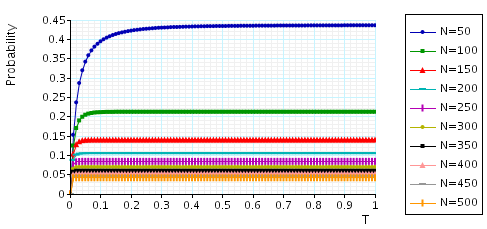
The maximum probability that a call can be dropped within t time units (assuming a non-guarded channel is free): the graph below presents the results for this property.
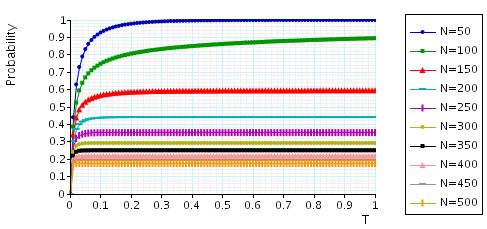
The minimum probability that a cell will be accepted within T time units (assuming no channels are free): the graph below presents the results for this property.
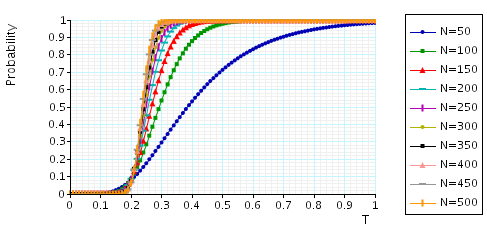
The expected number of calls in the cell at time T: the table and graph below presents the model checking statistics for this property.
| c: | T=1: | |||||
| Iters: | Time per iter: (s) | |||||
| MTBDD | Sparse | Hybrid | ||||
| 50 | 216 | 0.000880 | < 0.00001 | < 0.00001 | ||
| 100 | 551 | 0.001760 | 0.000018 | < 0.00001 | ||
| 150 | 669 | 0.002661 | < 0.00001 | < 0.00001 | ||
| 200 | 790 | 0.003557 | < 0.00001 | 0.000013 | ||
| 250 | 913 | 0.004545 | 0.000011 | 0.000011 | ||
| 300 | 1,060 | 0.005519 | 0.000009 | 0.000019 | ||
| 350 | 1,206 | 0.006650 | 0.000008 | 0.000017 | ||
| 400 | 1,351 | 0.007646 | 0.000007 | 0.000022 | ||
| 450 | 1,494 | 0.008963 | 0.000007 | 0.000027 | ||
| 500 | 1,637 | 0.009505 | 0.000012 | 0.000024 | ||
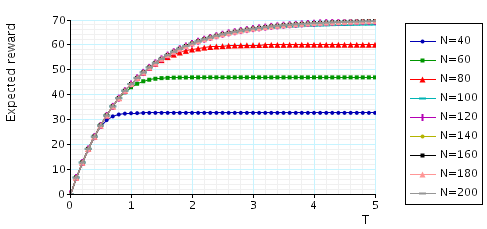
Lon run average properties: the table below gives the model checking statistics when computing the steady state probabilities for both the JOR and SOR methods when using PRISM's different engines.
| c: | JOR: | SOR: | |||||||
| Iters: | Time per iter: (s) | Iters: | Time per iter: (s) | ||||||
| MTBDD | Sparse | Hybrid | Sparse | Hybrid | |||||
| 50 | 301 | 0.001018 | < 0.00001 | < 0.00001 | 173 | < 0.00001 | < 0.00001 | ||
| 100 | 1,400 | 0.001960 | < 0.00001 | < 0.00001 | 771 | < 0.00001 | 0.000013 | ||
| 150 | 1,894 | 0.002829 | 0.000005 | 0.000011 | 1,139 | 0.000009 | 0.000018 | ||
| 200 | 2,254 | 0.003745 | 0.000004 | 0.000009 | 1,298 | 0.000015 | 0.000023 | ||
| 250 | 2,491 | 0.005122 | 0.000008 | 0.000012 | 1,419 | 0.000021 | 0.000028 | ||
| 300 | 2,686 | 0.005481 | 0.000007 | 0.000011 | 1,520 | 0.000020 | 0.000033 | ||
| 350 | 2,859 | 0.005726 | 0.000010 | 0.000017 | 1,611 | 0.000019 | 0.000037 | ||
| 400 | 3,020 | 0.005915 | 0.000013 | 0.000017 | 1,696 | 0.000024 | 0.000041 | ||
| 450 | 3,171 | 0.006346 | 0.000013 | 0.000019 | 1,776 | 0.000028 | 0.000056 | ||
| 500 | 3,316 | 0.008201 | 0.000015 | 0.000021 | 1,854 | 0.000032 | 0.000054 | ||
In the graphs below we have plotted the result for the probability that in the long run any call can be dropped and the expected number of calls in the cell in the long run.
